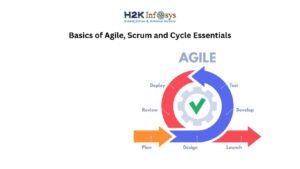Agile Finance Team are discovering that implementing Agile working methods aids in resolving these ongoing difficulties. As a result, businesses that adopt agility reap several advantages,
Similar to businesses in the financial services sector, finance activities and the Agile CFOs who oversee them are subject to unprecedented levels of social, economic, and technical change as well as regulatory pressure. Due to this, many finance teams are finding it difficult to maintain, much less enhance, daily tasks including reporting, compliance, planning, and forecasting.
Even more, financial teams are discovering that implementing Agile working methods aids in resolving these ongoing difficulties. As a result, businesses that adopt agility reap several advantages, such as:
- a rise in sales, brand awareness, and market share.
- quicker turnaround times and superior products.
- enhanced interactions with consumers.
- Greater openness and increased employee engagement.
Surprisingly, compared to other corporate functions like IT, marketing, operations, and HR, finance and accounting have some of the lowest acceptance rates for agile.
What is Agile Finance Team?
To begin with, we must distinguish Agile finance from Agile funding or budgeting. Agile budgeting and funding are more tactical issues that are typically addressed as part of an overall corporate Agile transformation, even though the finance department will undoubtedly be involved in these tasks. It is crucial to remember that Finance teams can adopt Agile methodologies without the corporation also doing so.

A finance team that approaches their job using the same Agile concepts that IT and software development teams have been employing for more than thirty years is known as an Agile finance department.
These principles include:
- an emphasis on delivering value rather than finishing pre-planned tasks.
- dividing up work into manageable pieces to enable efficient and continuous value delivery.
- a commitment to ongoing improvement through iterative delivery and ongoing feedback.
- Exceptional teamwork inside and between business units.
- an endeavour to give the best value while keeping procedures and deliverables simple.
How Agile principles apply to finance teams
An agile finance function concentrates on creating value through the following qualities, according to the Institute of Management Accountants (IMA) publication, An Agile Approach to Finance Transformation:
- efficient, scalable operations.
- Transparent, readily available metrics and data.
- Monitoring frequently to make sure the insight is appropriate.
- rapid, responsible change adaption.
- Teams that are strong, competent, and interdisciplinary.
There are three characteristics of an agile finance function:
- Operational Excellence: Agile organisations achieve operational excellence in finance by integrating cloud apps and streamlining processes to satisfy growing demands for velocities, accuracy, and control. Agile finance leaders, who make up 86% of the group, prioritise the cloud and digital first. Agile leaders can use technology to increase efficiency and make use of intelligent process automation.
- Digital Intelligence: Agile finance teams are knowledgeable about the generation of insights using cloud and cutting-edge technologies to drive business-value-creating decisions, identify hidden patterns, make precise planning and forecasting suggestions, and continuously learn from the never-ending stream of business data.
- Business Influence: Successful finance teams develop the organisational capabilities and skills necessary to go beyond reporting and apply data-driven insights to shape the course of the company. Finance executives have the power needed to collaborate with the business, suggest fresh approaches, and affect corporate strategy.
Tactically, this means that nimble, diverse Agile finance teams will often interact with internal clients (business and operational teams) to deliver projects and carry out recurring tasks in an iterative, incremental manner. Consequently, the internal procedures they implement will focus on delivering value often and well to these customers.


Examples of finance deliverables through the Agile lens
Some examples demonstrate how typical accounting and finance procedures like month-end close, reconciliations, accounts payable, and accounts receivable can all be readily adapted to Scrum or another comparable Agile methodology. To sum it up:
- All members of the finance and accounting team can see the monthly tasks like processing invoices, closing the ledger, and balancing accounts that have been assigned to a common backlog on a Scrum board, whether it be digital or physical.
- Internal audits might result in more regular delivery of results, chances for teams to fill gaps more quickly, and higher stakeholder engagement if they were carried out using Agile and Scrum. This is because an Agile or Scrum-based internal audit approach wouldn’t save the creation of the audit report for the very end.
- Weekly or biweekly sprints (time-boxed intervals of regular delivery throughout the project) can be used to organise the work to be done, and the completion of each sprint would logically deliver value because these activities directly contribute to the delivery of organisational value.
- Improvement projects could also be added to a central backlog to be handled by the team in priority order while still having time to complete their regular operational chores or responsibilities as teams work to normalise continuous improvement. As a result, after each sprint, one or more initiatives, or portions of the finished product (backlog items), would be delivered.
There are also many examples of Agile projects that Agile Finance can be applied to. It is important to familiarise yourself with as many of them as possible.
Why is Agile Finance Team important?
As was already mentioned, by adopting an Agile approach, contemporary financial teams can lessen the burden. Agile can also give Agile finance teams a major competitive advantage because so few of them now use it.
The significance of Agile finance is highlighted by the following statistic from the aforementioned Oracle study: “Businesses supported by Agile finance leaders are considerably more likely to report positive revenue growth (89% vs. 63%) and increasing profitability (95% vs. 70%).”
Conclusion
The secret to an Agile transformation’s success is adopting the same guiding principles throughout the entire process. That entails making gradual improvements to what you’ve already achieved by starting small. Agile Finance will be crucial to the future of Agile.

































